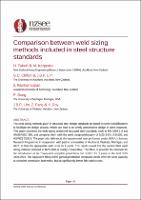Comparison between weld sizing methods included in steel structure standards

Download
Date
2024-04-09Authors
Taheri, Hafez
Karpenko, Michail
Clifton, G. Charles
Ramhormozian, Shahab
Dong, Pingsha
Lim, James B. P.
Roy, Krishanu
Fang, Zhiyuan
Metadata
Show full item recordAbstract
Although the weld sizing methods given in standards look simple, the actual stress distribution in most welds is complex. Some simplifications are assumed to make designing welds easier for design engineers in different steel design codes. However, the validity of some assumptions made in the sizing method for welds can be questioned. There are concerns that the current design procedures included in NZS 3404, AS 4100 and AS/NZS 5100.6 standards may lead to oversized welds compared to the same welds designed to other standards. This paper investigates the weld sizing method in the above steel design codes of New Zealand and Australia. It examines the weld sizing criteria of structural steel standards as EN 1993-1-8 and ANSI/AISC 360 and compares it with the weld design philosophy in Australasian standards. The paper makes references to the experimental tests performed under HERA’s Seismic Research Programme, in cooperation with partner universities UoA, AUT and UoW, to examine the difference between theoretical and empirical weld capacity. The results reveal that the current fillet weld sizing criterion included in NZS 3404 is conservative. This paper provides the rationale for the introduction of the “equivalent complete penetration butt welds” for T-butt joints to the draft NZS 3404:2024. The equivalent fillet and/or partial penetration compound welds offer the same capacity as complete penetration butt welds but at significantly lower fabrication costs.
